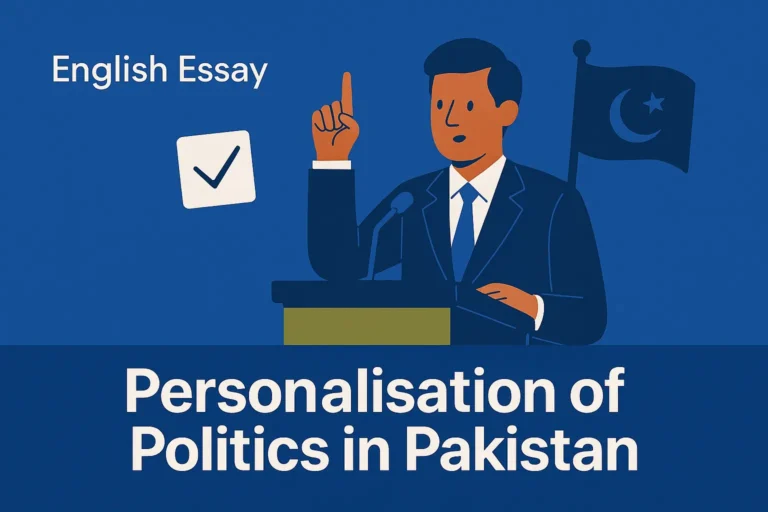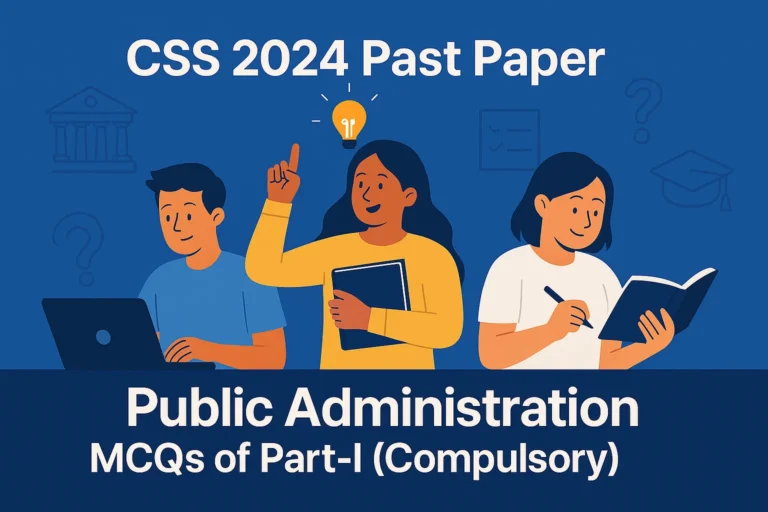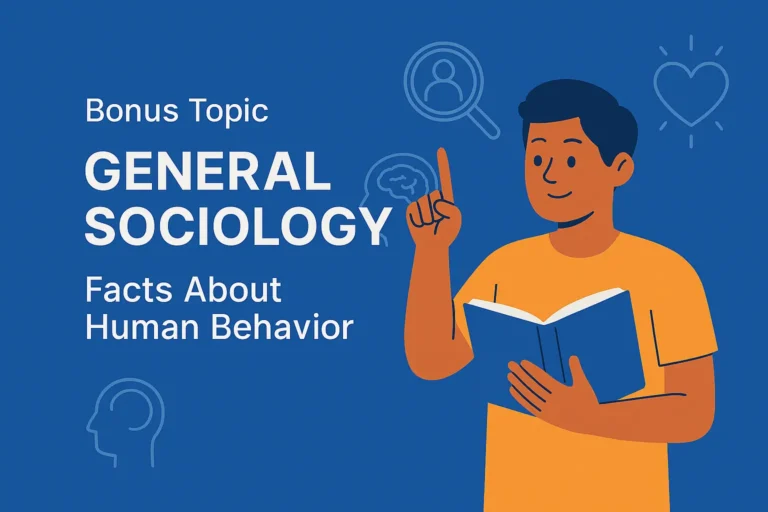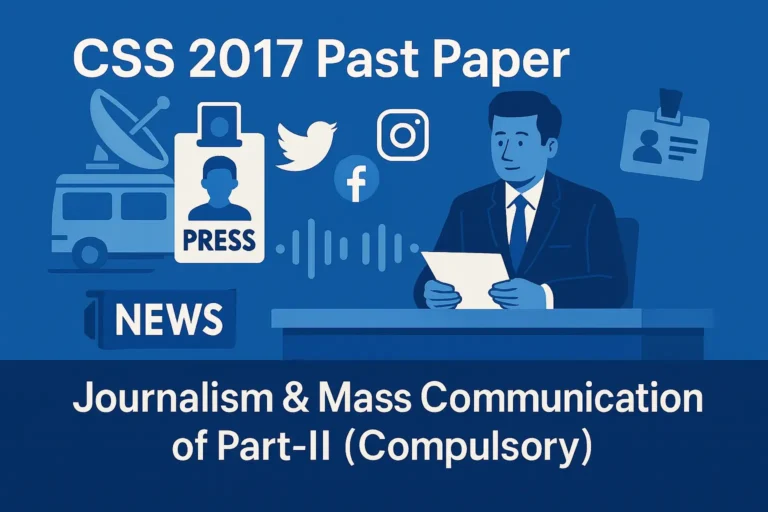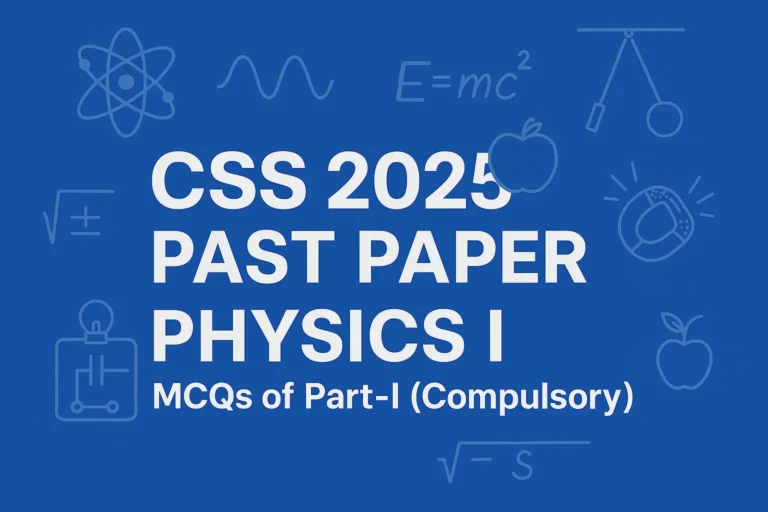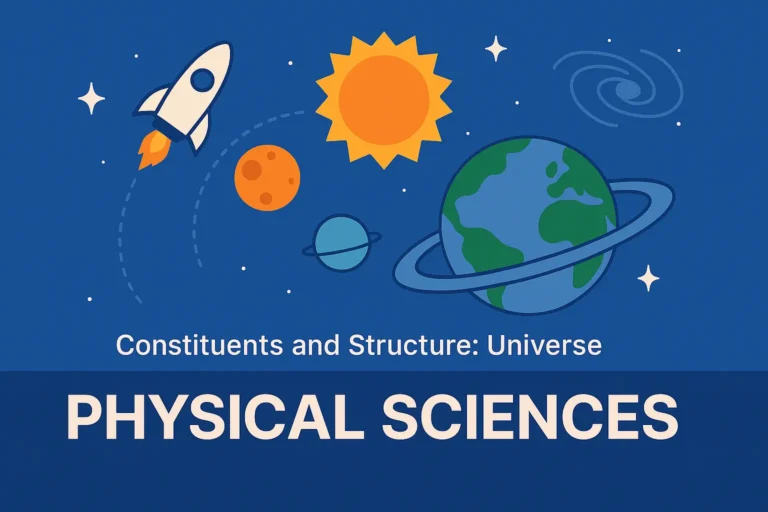CSS 2023 Special Exam Solved Past Paper – Journalism & Mass Communication Part-II (Compulsory)
Below is the solution to PART-II (COMPULSORY) of the CSS 2023 Special Exam Journalism & Mass Communication Paper.
Question 2
Logically elaborate the key principles of Wilbur Schramm communication model of 1954 in respect to Pakistani media landscape. Are the Pakistani media consumers have all or some of the model’s required elements? Comment.
Introduction
Wilbur Schramm was a famous communication theorist who made a big contribution to understanding how communication works. His 1954 communication model was more advanced than earlier ones because he focused not just on the sender and receiver, but also on how feedback, field of experience, and noise affects the whole process. In this answer, I will first explain the key points of his model and then link them to the Pakistani media situation.
Key Principles of Wilbur Schramm’s Model (1954)
- Sender-Encoder
The sender is the one who creates the message and puts it in a form that others can understand. In media, this is usually the journalist or media organization. - Message
This is the actual content — like news reports, videos, or social media posts. - Medium
The medium is the channel used to deliver the message, like TV, newspapers, radio, or digital platforms. - Receiver-Decoder
The receiver is the person or audience who gets the message and tries to understand it based on their own knowledge and experience. - Feedback
Feedback is how the receiver reacts and responds to the message. In modern times, feedback can be instant like comments, likes, or replies. - Field of Experience
This is very important. It means the background, culture, education, and knowledge both sender and receiver have. If both share common experiences, communication becomes easier. - Noise
Noise is any kind of disturbance that affects the message. It can be technical (like bad signal), or even social or political (like censorship or propaganda).
Application to Pakistani Media Landscape
In Pakistan, Schramm’s model helps to understand how media works, but not all elements function smoothly.
- Sender-Encoder in Pakistan
The media houses, journalists, vloggers, and even influencers act as senders. But the problem is, some of them are under political or corporate influence. This affects the objectivity of the message. - Message Quality
Many times, news reports in Pakistan are biased or sensationalized to gain TRPs. This weakens the quality of the message. - Mediums Used
Pakistan has all kinds of mediums — from PTV to ARY, and also digital platforms like YouTube and Facebook. But access is not equal in all areas. Rural areas still rely mostly on TV or radio. - Receiver-Decoder
The Pakistani audience is diverse. Some are educated and critical, while others believe anything they see, especially on social media. So, decoding of messages is not equal for all. - Feedback in Pakistan
Social media allows instant feedback, but not all media houses take public opinion seriously. Also, some people fear giving open feedback due to political pressure. - Field of Experience
This is where a big gap exists. Media people often belong to urban elite class, while many viewers are from rural or lower middle class. This mismatch of experience causes misunderstanding and low trust. - Noise in Pakistani Media
The biggest noise here is state control, fake news, and propaganda. Sometimes, media is used for political agendas, which damages communication.
Do Pakistani Media Consumers Have All Elements of Schramm’s Model?
Not really. Some elements are there, but many are weak or misused.
- Yes, they have access to media (medium), messages, and even feedback tools.
- But, many lack education, awareness, and media literacy, which are important for decoding the message correctly.
- Also, field of experience is too different between urban media producers and rural consumers.
- Noise is high, especially political and cultural noise, which disturbs proper communication.
Conclusion
Wilbur Schramm’s model shows that communication is a two-way process that depends on many factors. In Pakistan, although the basic structure of this model is present, the actual functioning is not ideal. Media freedom, audience education, and ethical journalism need to be improved. If these issues are addressed, then Pakistan can fully benefit from this model and improve its communication process between media and society.
Question 3
The Media hegemony theory argues that various factors including state, economic and social factors seriously affect the working of journalists and consequently the news contents. Discuss the theory and suggest measures to ensure an environment where the Pakistani journalists can work and report news independently.
Introduction
Media Hegemony Theory is a concept that explains how powerful groups in society control the media, and through that, they control public opinion. This theory was mostly developed by thinkers like Antonio Gramsci. It says that media is not always free or neutral — instead, it reflects the ideas of those who have money, political power, or influence. In simple words, media is used to protect the interest of the ruling class.
Now, when we look at the media in Pakistan, we can see that this theory is very true here. The state, economy, and society — all play a big role in shaping how journalists work and what kind of news gets shown to the public.
1. Understanding Media Hegemony Theory
- The theory says media is used to maintain the status quo.
- The powerful people use media to make their ideas look normal and natural, so people accept them without question.
- It controls not just what is shown, but also what is not shown in the news.
2. Role of State in Media Hegemony in Pakistan
- In Pakistan, the state influences media through censorship, pressure from PEMRA, and other tools.
- Sometimes journalists are forced to avoid sensitive topics like security issues, missing persons, or political criticism.
- There have been cases where channels were banned or fined for showing “anti-state” news.
- This creates a fearful environment where reporters self-censor their work.
3. Role of Economy in Media Hegemony
- Many big media houses are owned by business tycoons who have their own political or commercial interests.
- Journalists who try to report against powerful companies may lose their job.
- Advertisements control the media too. Big brands fund TV channels, so media avoids stories that go against them.
- Also, low wages for journalists make them more vulnerable to bribes and pressure.
4. Social Factors Affecting Journalism
- Pakistan is a religiously and culturally sensitive country. Reporting on topics like women rights, blasphemy laws, or minority issues can be dangerous.
- There is also extreme polarization in society. Media is divided into pro-government and anti-government camps.
- Reporters get harassed online and even physically attacked for expressing views different from the majority.
5. Consequences of Media Hegemony
- Biased news becomes common.
- Public opinion is manipulated to support the powerful groups.
- Truth is hidden or twisted.
- Investigative journalism is almost dead in Pakistan because no one wants to take risks.
- Media becomes an instrument of propaganda instead of truth.
6. Measures to Ensure Independent Journalism in Pakistan
To fix this situation and allow journalists to work freely, many steps are needed:
a) Stronger Legal Protection
- Government should pass and follow laws that protect journalists’ rights and give them freedom of expression.
- Attacks on journalists must be punished strictly.
b) Independent Media Regulatory Bodies
- PEMRA should be free from political control. It should not be used to silence channels that are critical of the government.
c) Ownership Transparency
- Media ownership must be clear. There should be rules to stop monopolies in the media industry.
d) Financial Support for Journalists
- Journalists should be given fair wages and job security, so they don’t fall into corruption or pressure.
e) Media Literacy in Society
- Public should be educated to understand biased news vs real news. A more informed audience will demand better journalism.
f) Support for Investigative Journalism
- NGOs, media houses, and even universities should promote and fund investigative work.
Conclusion
In Pakistan, media hegemony is a serious issue that blocks the path of honest journalism. Journalists are afraid, underpaid, and controlled, either by state rules or by economic forces. To build a strong democracy, free and fair media is necessary. That is only possible when journalists are allowed to do their job without fear or pressure. Pakistan must take strong steps to break the chains of hegemony and support independent journalism for the good of society.
Question 4
Many critics contend that, in the costume of global communication, cultural imperialism is taking place though Mass Media, in this digital age, resulting in the dilution of local cultures and languages. What policy measures would you suggest to protect the local culture, languages and traditions?
Introduction
In today’s world, mass media connects people across the globe, which is a good thing. But at the same time, it also brings some problems. One of them is cultural imperialism. This is when foreign cultures dominate local cultures, especially through movies, music, TV shows, and social media.
Global communication has made it easy for Western culture (mainly American) to spread everywhere. Now people in Pakistan are watching Netflix, using Instagram trends, and speaking in English more than Urdu or their regional languages. Slowly, our own culture, traditions, and languages are fading away.
1. What is Cultural Imperialism?
Cultural imperialism means the imposition of one culture’s values, language, and lifestyle over others, usually through media, education, and economy. It’s not done with force but through attractive content and global influence.
Examples:
- People prefer Hollywood over Lollywood.
- English songs are more popular than regional ones.
- Western fashion is considered modern; traditional clothes are seen as backward.
- Local languages like Balochi, Pashto, or Sindhi are not used much in digital platforms.
2. Role of Mass Media in Cultural Imperialism
Mass media is the main carrier of global culture. Through:
- Movies and TV dramas
- Social media platforms (YouTube, TikTok, etc.)
- Streaming services like Netflix and Amazon Prime
- Advertisements and fashion trends
The media shows Western lifestyles as ideal and superior. Our youth starts copying that and forgets their own culture.
3. Impact on Pakistani Culture and Language
- Language Shift: Youth use English or Roman Urdu online. Regional languages are dying slowly.
- Loss of Identity: Young people feel shame in following local customs.
- Fashion and Food Change: Traditional wear is ignored; junk food replaces desi food.
- Traditional Media Decline: Regional dramas, folk music, and literature get very little space on TV or online.
4. Policy Measures to Protect Local Culture and Language
To stop this cultural loss, the government and media should take some strong steps:
a) Promote Local Content
- Make more TV dramas, films, songs, and online content in regional languages.
- Give funds and awards for cultural programs, documentaries, and local artists.
b) Local Language Quotas in Media
- Like some countries, Pakistan should have a rule that TV and radio must air a certain % of local language content.
c) Digital Media Support for Local Creators
- Provide grants to YouTubers, bloggers, and influencers who make content in Urdu or regional languages.
- Build Pakistani streaming platforms that promote our content.
d) Cultural Education in Schools
- Teach students about their language, poetry, music, and history.
- Make folk stories, regional heroes, and cultural studies part of the school curriculum.
e) Subsidies and Scholarships for Cultural Research
- Fund universities and scholars who work on preserving folk traditions, language, and literature.
f) Ban/Filter Culturally Harmful Foreign Content
- Like Turkey and China, Pakistan can filter or ban content that goes directly against our values.
g) Public Campaigns to Promote Culture
- Launch national campaigns like “Proud to Speak My Language” or “My Culture My Identity”.
5. Role of PEMRA and Ministry of Information
- PEMRA should enforce local content laws.
- Ministry of Culture should actively support festivals, language days, and art shows.
Conclusion
Global communication has made the world a small village, but it should not make all villages look the same. Every culture has its own beauty. If we keep ignoring our local languages and traditions, we will lose our identity.
The solution is not to reject global media, but to balance it. We should consume global content, but also produce and promote our own content. With proper policies and efforts, we can protect our culture while living in the global age.
Question 5
Development Support Communication advocates for development at a community level. Discuss with reference to the development support communication’s theories, citing examples from indigenous rural communities.
Introduction
Development Support Communication (DSC) is a special branch of communication used to help communities improve their social, economic, and cultural life. It is not just about giving information — it is about changing behavior, solving local problems, and involving people in the development process.
DSC is very important for a country like Pakistan, where a big part of the population lives in rural and underdeveloped areas. These people need communication that talks in their language, addresses their needs, and helps them grow without losing their identity.
1. What is Development Support Communication?
Development Support Communication means using media and communication tools to support government and NGO development efforts, especially at the grassroots level. It focuses on:
- Health awareness
- Education
- Agriculture improvement
- Women empowerment
- Poverty reduction
Unlike commercial media, DSC focuses on community welfare, not profit.
2. Theories of Development Support Communication
There are several theories that guide DSC. Some important ones are:
a) Modernization Theory
- It says that underdeveloped countries must follow the path of developed nations.
- Communication should be used to spread modern values, education, and technology.
- Example: Using radio to teach modern farming to villagers.
b) Dependency Theory
- It criticizes modernization theory. It says poor countries are dependent on rich ones due to media and economic control.
- It supports using local media to tell local stories and reduce foreign influence.
c) Participatory Communication Theory
- This is the most popular DSC theory now.
- It says development should be two-way: the community must take part in planning and communication, not just receive information.
- Example: A rural women’s group makes a radio show about maternal health based on their own experiences.
3. DSC in Indigenous Rural Communities of Pakistan
In Pakistan, many rural communities have their own languages, customs, and needs. DSC can help them grow without forcing them to change their identity.
Examples:
- Radio programs in Sindhi or Pashto to teach farmers about new seeds and fertilizers.
- Mobile awareness vans in Balochistan promoting polio vaccination using local folk songs.
- Community theatre in villages showing the importance of girls’ education.
- FM radio in Gilgit-Baltistan spreading weather alerts and safety info for remote areas.
These types of communication work better than formal campaigns because people trust local voices and understand local culture.
4. Importance of Language and Local Culture
- For DSC to work, it must use regional languages like Saraiki, Balochi, Sindhi, etc.
- Messages should be simple, visual, and relevant.
- Local customs must be respected; for example, talking about family planning in a sensitive way.
5. Role of Media in DSC
- Radio is the most powerful DSC tool in rural Pakistan. It is cheap and easy to access.
- Community newspapers in Urdu or regional languages can share info on agriculture, weather, and education.
- Television dramas can raise awareness about child marriage, domestic violence, etc.
- Social media is slowly growing in rural youth but still not fully reliable due to internet issues.
6. Challenges of DSC in Pakistan
- Low literacy rate makes communication harder.
- Lack of trained communicators who understand both development and media.
- Funding problems in running local radio or print media.
- Government sometimes ignores local voices in policy-making.
7. Suggestions to Improve DSC in Pakistan
- Train local youth in media production for their own communities.
- Create more community radio stations with content made by locals.
- Include DSC content in school curriculum.
- NGOs and government should coordinate their communication efforts to avoid confusion.
- Use religious leaders and village elders to spread development messages with trust.
Conclusion
Development Support Communication is not just a tool, it is a lifeline for rural and indigenous communities. If used properly, DSC can change lives — from better health to improved farming, from girl’s education to women’s rights. But for this to happen, the communication must be local, simple, participatory, and respectful of culture.
Pakistan has many successful examples of DSC, but we need more organized policies and funding to expand it across all rural areas, so that development reaches every corner of the country — not just the cities.
Question 6
What are various dimensions of International Communication? Support your answer with relevant examples.
Introduction
International Communication means the exchange of information and messages across national borders. It includes everything like international news, cultural content, political messages, global business, and diplomatic communication. It is an important field because the world is now more connected than ever before due to technology and globalization.
International communication is not just about one country talking to another. It also includes global media, cultural exchange, foreign policy, internet networks, and more. This communication affects how countries see each other, how businesses grow, and how public opinion is shaped around the world.
1. Dimensions of International Communication
There are many dimensions or aspects of international communication. Below are the most important ones with examples:
a) Political Dimension
- This involves how countries use media to spread political ideologies or support foreign policies.
- Governments use tools like public diplomacy, state-run channels, and embassies to spread their political stance.
- Example: Russia Today (RT) and China’s CGTN promote their governments’ views to global audiences.
- Example: During the Gaza or Kashmir conflicts, countries try to spread their narrative through international media.
b) Economic Dimension
- Media is also a business, and international communication affects global trade and advertising.
- Big media corporations like CNN, BBC, or Al Jazeera operate in many countries, earning revenue and spreading influence.
- Global advertising campaigns are shaped by multinational companies like Coca-Cola, Samsung, etc.
- Example: YouTube and Meta (Facebook) earn millions from ads in developing countries without having physical offices there.
c) Cultural Dimension
- This is about the global flow of culture, language, fashion, movies, and lifestyle through media.
- Western culture, especially American pop culture, is spread worldwide via Netflix, Hollywood, Spotify, etc.
- Example: Pakistani youth follow US music, fast food culture, and fashion more than their own local traditions.
- This also causes cultural imperialism, where local cultures are weakened.
d) Technological Dimension
- International communication depends on global technology — like satellites, fiber optics, and the internet.
- Tech companies like Google, Apple, and Amazon control global information flow.
- Countries also cooperate or fight over 5G, cybersecurity, and data privacy.
- Example: The ban of TikTok in some countries due to security concerns is part of this tech dimension.
e) Legal and Ethical Dimension
- Different countries have different media laws, censorship rules, and data policies.
- International communication faces challenges like fake news, hate speech, privacy violations, and surveillance.
- There are global efforts to make laws, but it’s still a big mess.
- Example: European Union’s GDPR law controls how tech companies use personal data across borders.
f) Development Dimension
- International communication is used to help developing countries through information sharing.
- UN agencies, NGOs, and global broadcasters share content about health, education, human rights, etc.
- Example: UNESCO and BBC Media Action run campaigns in Africa and South Asia about women’s rights and child health.
g) Conflict and War Dimension
- Media is often used as a weapon in international conflicts.
- Countries run propaganda campaigns to justify wars or attacks.
- Example: In the Ukraine-Russia war, both sides use international media to win global support.
2. Importance of International Communication
- Builds understanding between cultures
- Helps in disaster management and global alerts
- Supports international trade and tourism
- Shapes global political and cultural narratives
- Plays a key role in global diplomacy and soft power
3. Challenges in International Communication
- Language barriers
- Media bias and control
- Digital divide (rich countries have better access)
- Misinformation and propaganda
- Domination by Western media giants
4. Pakistan’s Role in International Communication
- Pakistan has state media like PTV World and Radio Pakistan for international news.
- Private channels like Geo, ARY, Dunya sometimes reach global audiences via YouTube and satellite.
- But Pakistan lacks a strong voice in the global media space.
- Need to invest in global digital platforms, local-language subtitles, and diplomatic media.
Conclusion
International communication connects the world, but it is not equal. Powerful countries dominate, while smaller nations struggle to make their voices heard. By understanding its many dimensions — political, economic, cultural, technological, and legal — we can see how deeply it shapes the world today.
To protect local interests, countries like Pakistan must invest in media, technology, and cultural content, so that they don’t get left behind in this global media race.
Question 7
While the advent of digital media has expanded the boundaries of knowledge as well as opportunities, it has also proved to be a disruptive factor in political, social and economic terms. Comment.
Introduction
Digital media has changed the world. It made everything faster, more connected, and more open. With one click, you can learn anything, talk to anyone, and share your views. Platforms like Facebook, YouTube, Twitter (X), Instagram, and TikTok are now part of daily life.
But while digital media brought knowledge, freedom of speech, and job opportunities, it also brought serious problems in politics, society, and economy. It became a double-edged sword — useful, but dangerous if not handled properly.
1. Expansion of Knowledge and Opportunities
Before going into problems, we should understand the benefits.
a) Access to Information
- Anyone with a phone and internet can now read news, watch documentaries, learn skills, etc.
- Platforms like Khan Academy, YouTube tutorials, and even free university courses are open to all.
b) Opportunities for Business
- Many people earn online through freelancing, e-commerce, vlogging, and blogging.
- In Pakistan, digital media created jobs for graphic designers, video editors, content creators, etc.
c) Political Awareness
- People now discuss politics openly. Social media gave power to the public.
- Political parties use digital media for campaigns and direct communication with voters.
2. Disruptive Effects of Digital Media
Despite all the benefits, digital media has caused many problems, especially in politics, society, and economy.
A) Political Disruption
i) Fake News and Misinformation
- Many political rumors and false news spread fast on social media.
- Example: During elections, fake videos or edited posts can mislead voters.
ii) Online Manipulation
- Political parties use bots and fake accounts to attack opponents or promote hashtags.
- Countries like Russia and the US have faced problems of election interference through digital campaigns.
iii) Hate Speech and Polarization
- Political debates online often become toxic.
- People start hating each other based on party or ideology, making democracy weaker.
B) Social Disruption
i) Mental Health Issues
- Constant scrolling, likes, and online competition has caused depression, anxiety, especially among youth.
ii) Loss of Privacy
- People post everything online, and many don’t know how their data is being used.
iii) Cultural Damage
- Western content is everywhere. Local traditions and languages are getting ignored.
iv) Cyberbullying and Harassment
- Many people, especially women and minorities, are targeted online with abuse and threats.
C) Economic Disruption
i) Job Replacement
- Automation and AI driven by digital platforms is replacing many traditional jobs.
ii) Unfair Earning Models
- Big platforms like YouTube and Facebook earn huge money from users in countries like Pakistan but pay very little back.
- Local businesses suffer due to online shopping giants like Amazon, Daraz, etc.
iii) Digital Divide
- Rich urban areas enjoy fast internet and make money.
- Poor rural areas still have low access, so inequality is increasing.
3. The Case of Pakistan
In Pakistan, digital media has brought many changes:
- Political campaigns are now run on Twitter/X and YouTube.
- Young people are earning through TikTok and freelancing.
- But at the same time, there is online extremism, fake news, cybercrime, and lack of digital literacy.
The government tried to regulate digital media, but many rules are vague or misused to silence critics.
4. What Should Be Done? (Suggestions)
- Digital literacy programs should be started in schools and colleges.
- Government should make fair digital media laws that protect people without killing free speech.
- Mental health support, especially for teens, should be increased.
- Encourage creation of local content in Urdu and regional languages.
- Invest in rural internet to reduce digital gap.
Conclusion
Digital media is like fire. If used right, it gives light and warmth. If used wrong, it burns. It has opened the world to us but also created new dangers. The key is to balance — enjoy the benefits while managing the risks.
Pakistan must educate its citizens, improve internet access, and protect freedom and privacy to truly benefit from digital media. Otherwise, the disruption will become destruction.
Question 8
Write notes on any TWO of the following:
a. Libel, Defamation and type of Propaganda
b. Press Council of Pakistan (PCP)
c. Comment on the Pakistani media conglomerates’ failure in framing of code of ethics for itself.
a. Libel, Defamation and Types of Propaganda
Libel and Defamation
- Defamation means damaging someone’s reputation by spreading false information.
- It can be spoken (called slander) or written/published (called libel).
- Libel is a form of defamation that is permanent — like a newspaper article, TV broadcast, or online post.
- For example, if a newspaper wrongly accuses a person of corruption without proof, it is libel.
- In Pakistan, defamation laws exist under Defamation Ordinance 2002, but they are rarely applied properly.
Types of Propaganda
Propaganda means spreading ideas or information to influence public opinion, usually with a bias. It’s used in politics, war, advertising, and media.
Here are main types:
- Bandwagon – Convincing people to do something because “everyone else is doing it.”
Example: “Vote for Party A, it’s the most popular party!” - Name Calling – Using negative words for the opponent to create hate.
Example: Calling someone a “traitor” without proof. - Glittering Generalities – Using attractive words with no real explanation.
Example: “We stand for peace, justice, and progress.” - Transfer – Connecting something respected with a product or idea.
Example: A soldier promoting a political party. - Testimonial – Using celebrities or public figures to endorse something.
Example: A cricketer supporting a mobile company. - Fear – Scaring people to follow an idea or action.
Example: “If you don’t vote for us, the country will collapse.” - Plain Folks – Presenting leaders as ordinary people.
Example: A politician eating at a dhaba to show he is ‘one of us’.
Conclusion
In Pakistan, propaganda is often used in politics and religious matters, and defamation cases are rising due to social media abuse.
b. Press Council of Pakistan (PCP)
Introduction
The Press Council of Pakistan (PCP) is a regulatory body made to promote ethical journalism and protect press freedom. It was created under the Press Council Ordinance 2002.
Objectives of PCP
- Ensure responsible journalism by promoting code of ethics in media.
- Protect freedom of press as per the Constitution.
- Handle public complaints against newspapers or journalists.
- Maintain balance between freedom and responsibility in media reporting.
Structure of PCP
- The council consists of 19 members, including:
- Retired judges
- Journalists
- Media house owners
- Representatives from civil society
- The chairman is usually a retired Supreme Court or High Court judge.
Functions of PCP
- It can investigate complaints from the public.
- It has the power to warn or recommend action against newspapers that violate ethical rules.
- It publishes the “Code of Ethics for Press” which journalists are supposed to follow.
Challenges Faced by PCP
- Lack of enforcement power — It can’t fine or ban anyone directly.
- Political interference — Some members are appointed politically, so they may show bias.
- Low public awareness — Most people don’t know they can complain to PCP.
- Many journalists and media houses ignore the council’s guidelines.
Conclusion
The idea of PCP is good, but to make it effective, it must be independent, active, and strongly enforced. Also, media houses must take it seriously and promote ethical journalism.
c. Pakistani Media Conglomerates’ Failure in Framing of Code of Ethics for Itself.
Introduction
In Pakistan, media conglomerates face significant challenges in framing and adhering to a clear and unbiased code of ethics. This failure is primarily due to several systemic issues that hinder the proper implementation of ethical practices in the media industry.
Despite the existence of various media regulatory bodies like the Press Council of Pakistan (PCP), the media conglomerates often operate without a consistent and enforceable code of ethics, which results in biased reporting, sensationalism, and lack of accountability.
1. Lack of Regulatory Enforcement
The failure to implement an effective code of ethics is partly due to the inadequate enforcement of existing regulatory frameworks. Media houses in Pakistan often prioritize profit over responsible journalism, leading to the spread of sensational, misleading, and sometimes harmful content. The Press Council of Pakistan, though established to promote ethical journalism, lacks sufficient power to effectively penalize media organizations for ethical violations, thus weakening its role in ensuring media responsibility.
2. Political and Corporate Influence
Another key factor contributing to this failure is the political and corporate influence over media conglomerates. Many media outlets in Pakistan are owned or funded by political figures or business tycoons, which leads to biased reporting that favors their interests. As a result, news content is often manipulated to reflect particular political ideologies, sidelining journalistic objectivity. This lack of independence significantly weakens the establishment of an impartial code of ethics that could hold media accountable.
3. Financial Pressure
Financial constraints also play a crucial role in the failure to establish a robust ethical code. With the intense competition in the media sector, particularly in television broadcasting, media houses often resort to sensationalism and clickbait content to attract larger audiences and increase revenue from advertisements. This business model undermines ethical journalism, as sensational stories tend to trump in-depth, factual reporting. Therefore, the need for profit often conflicts with the responsibility to uphold high journalistic standards.
4. Public Perception and Lack of Trust
The general public in Pakistan often views the media as unreliable due to the prevalence of biased reporting and lack of transparency. Without a solid code of ethics, the media further erodes public trust by publishing unverified claims, spreading rumors, and engaging in unnecessary scandals. This leads to a vicious cycle where the public, lacking faith in the media, turns to alternative sources of information, which may not always be credible.
Conclusion
For Pakistani media conglomerates to frame a successful and universally accepted code of ethics, there must be a combination of self-regulation, political independence, and public accountability. Media houses need to understand that their role is not just to entertain or generate revenue, but also to inform the public accurately and ethically.
Ensuring the effective implementation of ethical guidelines will require stricter regulatory oversight, transparent ownership structures, and greater focus on journalistic integrity to rebuild public trust and deliver content that genuinely serves the needs of the people.

